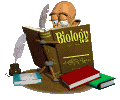| Chapter
Objectives
- Desribe the 4 unique
characteristics of chordates
- Distinguish between
the three subphyla of the phylum Chordata and give examples
of each
- Describe the specialized
characteristics found in the subphylum Vertebrata and explain
how each is beneficial to survival
- Compare and contrast
members of Agnatha, Placadermi, and Chondrichthyes
- Explain how members
of the class Osteichthyes have become so diversified
- Summarize the evidence
supporting the fact that amphibians evolved from crossopterygians
- Distinguish between
the three orders of living amphibians
- List the distinguishing
characteristics of members of the class Reptilia and explain
any special adaptations to the terrestrial environment
- Explain how environmental
changes during the Cretacous Period may have affected the
dinosaurs
- List the distinguishing
characteristics of members of the class Aves and explain any
special adaptations for flight
- Summarize the evidence
supporting the fact that birds evolved from reptilian ancestors
- Explain why mammals
underwent an adaptive radiation during the Cenozoic
- Distinguish between
monotreme, marsupial, and placental mammals
- Explain how convergent
evolution produced marsupial and placental ecological counterparts
on different continents
- Compare and contrast
the four main evolutionary lines of placental mammals
- Describe the characteristics
found in early primates which indicate an arboreal evidence
- Appraise the significance
of the three most prominent misconceptions about human evolution
- Diagram an evolutionary
tree for humans
- Explain how humans have
influenced the extinction rates of other organisms
|
| Chapter
Terms:
| vertebrates
chordates
notochord
urochordates
tunicates
lancelets
cephalochordates
soites
paedogenesis
neural crest
tetrapods
amniotic egg
amniotes
Superclass Agnatha
ostracoderms
Superclass Gnathostomata
placoderms
Class Chondrichthyes
spiral valve
lateral line system |
oviparous
ovoviviparous
viviparous
cloaca
Class Osteichthyes
operculum
swim bladder
ray-finned fishes
lobe-finned fishes
lung fishes
Subclass Sarcopterygii
Class Amphibia
urodeles
anurans
apodans
extraembryonic membrane
Class Reptilia
ectotherms
synapsids
sauropods |
anapsids
diapsids
therapsids
endothermic
Chelonia
Squamata
Crocodilia
Class Aves
ratites
carinates
passeriforms
Class Mammalia
placenta
therapsids
monotremes
eutherial mammals
prosimians
anthropoids
paleoanthropology
mosaic evolution |
|
| Chapter
Outline Framework
- Invertebrate Chordates
and the Origin of Vertebrates
- 4 anatomical features
characterize phylum Chordata
- dorsal hollow nerve
cord
- notochord
- gill slits
- Invertebrate chordates
provide clues to the origin of vertebrates
- Introduction to the
Vertebrates
- Neural crest, cephalization,
vertebral column, and a closed circulatory system characterize
subphylum Vertebrata
- Overview of vertebrate
diversity
- Subclass Agnatha:
Jawless Vertebrates
- Lampreys and hagfishes
are the only extant agnathans
- Superclass Gnathostomata
I: The Fishes
- Vertebrate jaws
evolved from skeletal supports of the pharyngeal slits
- A cartilaginous
endoskeleton reinforced by calcfied granules is diagnositc
of class Chondrichthyes
- A bony endoskeleton,
operculum, and swim bladder are hallmarks of class Osteichthyes
- Superclass Gnathastomata
II: The Tetrapods
- Amphibians are the
oldest class of tetrapods
- Evolution of the
amniotic egg expanded the success of vertebrates on land
- A reptilian heritage
is evident in all amniotes
- Birds began as flying
reptiles
- Mammals diversified
extensively in the wake of the Cretaceous entinctions
- Primates and the
Phylogeny of Homo sapiens
- Primate evolution
provides a context for understanding human origins
- Humanity is one
very young twig on the vertebrate tree
back
to top |
|

